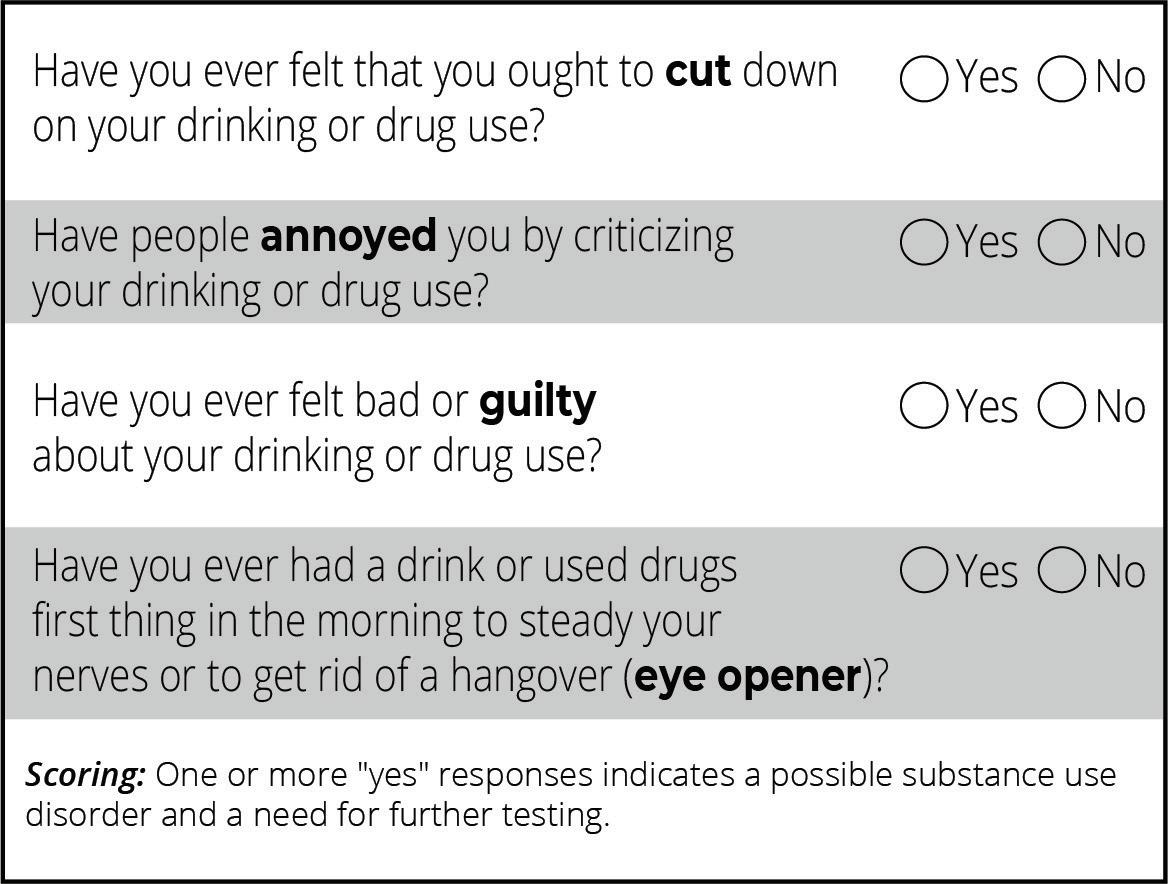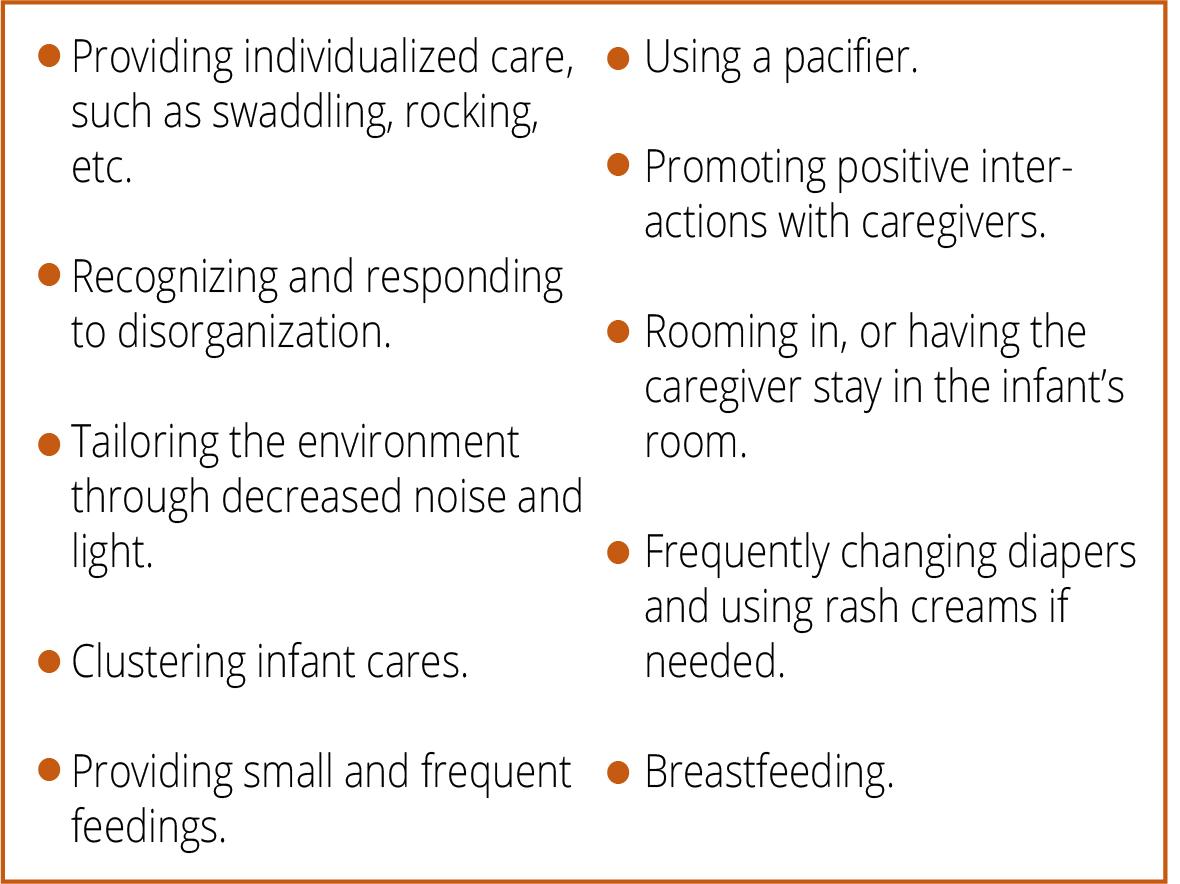
5 minute read
Medication-Assisted Treatment
Methadone: a synthetic, long-acting opioid that prevents withdrawal symptoms, decreases cravings, and does not have a euphoric effect if used appropriately.
Buprenorphine: an opioid-similar drug that is used by itself or in combination with naloxone (an opioid antagonist) to prevent the euphoric high effect of the opioid.
Naltrexone: an opioid antagonist that removes the euphoric high of opioid use. Naltrexone is rarely used in pregnancy. Note that Kratom, an opioid-like herbal extract used for pain relief, is used recreationally. It should not be used during pregnancy.10
Postpartum females who have an opioid use disorder (OUD) are more likely to overdose in the postpartum period compared to the prenatal period. This could be attributed to the lack of resources provided for females with OUD. Professional peer support, where clients work with someone who has overcome similar behavioral health challenges, can be a less stigmatizing environment for females who are pregnant.17
How Do Babies Get Needed Help?
Supportive measures can prevent the use of medication or decrease the amount of medication needed to treat NAS in infants.5
Note. Information was adapted. 11,12
How Do Moms Get Needed Help?
Infants born where harsh penalties for substanceusing pregnant females exist had higher rates of NAS than those born in states without such punitive policies. Many individuals with SUD reported they did not want to alert anyone that they used substances for fear of losing the custody of their child. The fear of losing custody can keep females from seeking treatment or from being compliant in their treatment.
Females who use substances during the prenatal and postpartum periods should seek health care providers who are respectful, empathic, and willing to have a collaborative relationship. This type of care will go further than stern reprimands to encourage engagement with clinical services and reduce feelings of stigma.3
Sources 5,6
Breastfeeding is recommended for many infants with NAS. Breastfeeding should be encouraged for mothers who are currently abstaining from substances or receiving MAT as prescribed.5,7,10 If an infant previously diagnosed with NAS is displaying any developmental problems, it is important to talk to the child’s pediatrician, who may refer the child to an early intervention service.5

What Can Communities Do?
Community members can minimize diversion of medications by safely disposing of prescription opioids. All unused or expired medications must be disposed of properly. See the suggestions for proper methods for safe medication disposal in the picture below.
Proper Medication Disposal Steps
Drop Box At Home Drug TakeBack Event
Medication drop boxes are a free and permanent method to dispose of medications. Drop boxes can be located at participating pharmacies and law enforcement agencies.
Source
Mix the medications with kitty litter, coffee grounds, or a soiled diaper and place in a sealed bag and then dispose of in the trash. Never flush down the toilet, sink, or throw in the garbage untreated.
Biannual drug take-back community events are held on the last Saturday of April and October every year across Utah.
Everyone can also work to give support to those who use substances or might be struggling due to NAS. Avoiding stigma helps individuals get the help they need.
Additional Resources
Use these websites and resources to find more information on treatment for substance use during pregnancy. Remember to consult a doctor or health care professional before starting any treatment program.
Organization Website
Al-Anon/Alateen al-anon.org/
Alliance for Innovation on Maternal Health safehealthcareforeverywoman.org/aim/ Communities That Care communitiesthatcare.net/
CRAFT Family Support myusara.com/support/ craft/
Early Intervention Program https://health.utah.gov/ cshcn/programs/babywatch.html
Naloxone naloxone.utah.gov/
National Harm Reduction Coalition harmreduction.org/
National Substance Use Treatment Locator findtreatment.gov/
National Suicide Prevention Lifeline Dial 988 suicidepreventionlifeline. org/
Parents Empowered parentsempowered.org/
SafeUT safeut.med.utah.edu/
SMART Recovery myusara.com/smart-recovery-at-usara/
Substance Abuse Mental Health Services Administration (SAMHSA) samhsa.gov 1-800-662-HELP (4357)
The Opidemic opidemic.org/
United Way (2-1-1) 211utah.org/
Use Only as Directed useonlyasdirected.org/
USU Health Extension: Advocacy, Research Teaching (HEART) Initiative extension.usu.edu/heart/
Utah Coalitions for Opioid Overdose Prevention ucoop.utah.gov/
Utah Department of Human Services, Substance Abuse and Mental Health dsamh.utah.gov/
Utah Poison Control Center (1-800-222-1222) poisoncontrol.utah.edu/
Utah Prevention Coalition Association utahprevention.org/
1 Sebastiani, G., Borrás-Novell, C., Casanova, M. A., Pascual Tutusaus, M., Ferrero Martínez, S., Gómez Roig, M. D., & García-Algar, O. (2018). The effects of alcohol and drugs of abuse on maternal nutritional profile during pregnancy. Nutrients, 10(8), 1008. https://doi.org/10.3390/nu10081008
2 Viteri, O. A., Soto, E. E., Bahado-Singh, R. O., Christensen, C. W., Chauhan, S. P., & Sibai, B. M. (2015). Fetal anomalies and longterm effects associated with substance abuse in pregnancy: A literature review. American Journal of Perinatology, 32(5), 405–416. https://doi.org/10.1055/s-0034-1393932
3 McQueen, K., & Murphy-Oikonen, J. (2016). Neonatal abstinence syndrome. New England Journal of Medicine, 375(25), 2468–2479. https://doi.org/10.1056/NEJMra1600879
4 Watson, C., Mallory, A., & Crossland, A. (2019). The spiritual and ethical implications of medication-assisted recovery in pregnancy: Preserving the dignity and worth of mother and baby. Social Work & Christianity, 46(3).
5 Patrick, S. W., Barfield, W. D., Poindexter, B. B., Cummings, J., Hand, I., Adams-Chapman, I., Aucott, S. W., Puopolo, K. M., Goldsmith, J. P., Kaufman, D., Martin, C., Mowitz, M., Gonzalez, L., Camenga, D. R., Quigley, J., Ryan, S.A., & Walker-Harding, L. (2020). Neonatal opioid withdrawal syndrome. Pediatrics, 146(5). doi: 10.1542/peds.2020-029074
6 Jansson, L. M. (2021, September 2). Neonatal abstinence syndrome. UpToDate. Retrieved April 24, 2022, from https://www.uptodate.com/contents/neonatal-abstinence-syndrome#H1
7 Saia, K. A., Schiff, D., Wachman, E. M., Mehta, P., Vilkins, A., Sia, M., Price, J., Samura, T., DeAngelis, J., Jackson, C. V., Emmer, S. F., Shaw, D., & Bagley, S. (2016). Caring for pregnant women with opioid use disorder in the USA: Expanding and improving treatment. Current Obstetrics and Gynecology Reports, 5(3), 257–263.
8 National Institute of Mental Health (2021, March). Substance use and co-occurring mental disorders. U.S. Department of Health and Human Services. Retrieved April 25, 2022, from https://www.nimh.nih.gov/health/topics/substance-use-and-mentalhealth#:~:text=A%20substance%20use%20disorder%20(SUD,most%20severe%20form%20of%20SUDs
9 Centers for Disease Control and Prevention (CDC). (2022, April 6). Fast facts: Preventing adverse childhood experiences. Violence Prevention. https://www.cdc.gov/violenceprevention/aces/fastfact.html
10 Seligman, N. S., Rosenthal, E., & Berghella, V. (2021, November 10). Overview of management of opioid use disorder during pregnancy. UpToDate. Retrieved April 25, 2022, from https://www.uptodate.com/contents/overview-of-management-of-opioid-usedisorder-during-pregnancy?topicRef=5016&source=see_link
11 Brown, R. L., & Rounds, L. A. (1995). Conjoint screening questionnaires for alcohol and other drug abuse: Criterion validity in a primary care practice. Wisconsin Medical Journal, 94(3), 135–140.
12 Hinkin, C. H., Castellon, S. A., Dickson-Fuhrman, E., Daum, G., Jaffe, J. & Jarvik, L. (2001), Screening for drug and alcohol abuse among older adults using a modified version of the CAGE. The American Journal on Addictions, 10, 319–326. https://doi.org/10.1111/j.1521-0391.2001.tb00521.x
13 Faherty, L. J., Stein, B. D., & Terplan, M. (2020). Consensus guidelines and state policies: The gap between principle and practice at the intersection of substance use and pregnancy. American Journal of Obstetrics & Gynecology MFM, 2(3), 100137. https://doi.org/10.1016/j.ajogmf.2020.100137
14 Howard, H. (2015). Experiences of opioid-dependent women in their prenatal and postpartum care: Implications for social workers in health care. Social Work in Health Care, 55(1), 61–85. https://doi.org/10.1080/00981389.2015.1078427
15 Stone R. (2015). Pregnant women and substance use: Fear, stigma, and barriers to care. Health & Justice, 3, 2. https://doi.org/10.1186/s40352-015-0015-5
Note. References within Stone’s article include:
Murphy, S., & Rosenbaum, M. (1999). Pregnant women on drugs: Combating stereotypes and stigma. Rutgers University Press. Poland, M. L., Dombrowski, M. P., Ager, J. W., & Sokol, R. J. (1993). Punishing pregnant drug users: enhancing the flight from care. Drug and alcohol dependence, 31(3), 199–203.
Roberts, S. C., & Nuru-Jeter, A. (2010). Women’s perspectives on screening for alcohol and drug use in prenatal care. Women’s Health Issues, 20(3), 193–200.
Roberts, S. C., & Pies, C. (2011). Complex calculations: how drug use during pregnancy becomes a barrier to prenatal care. Maternal and child health journal, 15, 333–341.
16 Proulx, D. & Fantasia, H. C. (2021), The lived experience of postpartum women attending outpatient substance treatment for opioid or heroin use. Journal of Midwifery & Women’s Health, 66, 211–217. https://doi.org/10.1111/jmwh.13165
17 Hand, D. J., Short, V. L., & Abatemarco, D. J. (2017). Treatments for opioid use disorder among pregnant and reproductive-aged women. Fertility and Sterility, 108(2), 222–227. https://doi.org/10.1016/j.fertnstert.2017.06.011
18 Use Only as Directed. (2022). Throw out. Know Your Script. https://useonlyasdirected.org/throw-out/


